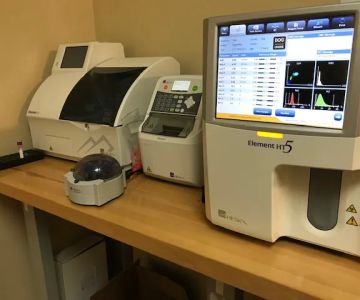What is an Associate Veterinarian? Understanding the Role and Responsibilities
If you're considering a career in veterinary medicine or simply curious about the various roles within veterinary practices, you might be wondering, "What is an associate veterinarian?" Having worked in the veterinary field for several years, I’ve learned that the position of an associate veterinarian is one of the most vital in a veterinary practice. This role is central to animal care and ensures that patients receive the treatment they need, but what exactly does it entail? In this article, I will break down the responsibilities, training, and day-to-day experiences of an associate veterinarian.
pgsql复制- 1. The Role of an Associate Veterinarian
- 2. Key Responsibilities of an Associate Veterinarian
- 3. Required Training and Education for Associate Veterinarians
- 4. Challenges and Rewards of the Associate Veterinarian Role
- 5. Career Path and Advancement Opportunities for Associate Veterinarians
1. The Role of an Associate Veterinarian
As I’ve discovered in my time working in veterinary clinics, an associate veterinarian is an integral member of the veterinary team. The role of an associate veterinarian typically involves diagnosing, treating, and preventing diseases in animals. They work alongside other veterinary professionals, including technicians, assistants, and specialists, to provide the best care possible to pets, farm animals, and wildlife, depending on the practice. However, unlike senior or managing veterinarians, associate veterinarians are typically not the owners of the practice and work under the direction of a practice owner or senior veterinarian.
What I love about this role is that it provides a perfect blend of hands-on animal care and collaboration within a veterinary team. An associate veterinarian’s job is dynamic, and each day brings a mix of challenges, learning opportunities, and rewards. Their expertise is often the first line of defense for pet owners seeking treatment for their animals.
2. Key Responsibilities of an Associate Veterinarian
The responsibilities of an associate veterinarian can vary depending on the size and type of practice they work in. However, I’ve found that many of the core duties are consistent across the field. Some of the primary responsibilities include:
Diagnosis and Treatment
One of the most important roles of an associate veterinarian is diagnosing and treating animals. This involves conducting physical exams, performing diagnostic tests such as blood work or X-rays, and interpreting results to determine the best course of treatment. I’ve watched many associates expertly diagnose conditions from minor illnesses to more complex medical issues. Their ability to think critically and communicate findings to pet owners is crucial in delivering effective care.
Surgery and Medical Procedures
In many practices, associate veterinarians also perform surgeries and other medical procedures. These can range from routine spaying and neutering to more complex surgeries such as tumor removals or orthopedic procedures. I’ve always admired the skill and precision required for these tasks, and it’s one of the aspects that makes the role so rewarding. They also monitor patients post-surgery to ensure their recovery is progressing as expected.
Client Communication and Education
Communicating with pet owners is another key part of an associate veterinarian’s role. I’ve found that the ability to explain medical conditions, treatment options, and preventive care is essential in building trust with clients. Clients often look to their veterinarian for advice on their pet’s health, diet, behavior, and overall well-being. An associate veterinarian must be able to educate pet owners on how they can provide the best care for their animals.
Record Keeping and Administrative Tasks
In addition to clinical tasks, associate veterinarians are also responsible for maintaining detailed patient records. Accurate documentation is vital for tracking the progress of treatments, diagnosing recurring issues, and ensuring that all necessary procedures are followed. I’ve learned that staying organized and thorough with record-keeping helps ensure the continuity of care for animals over time.
3. Required Training and Education for Associate Veterinarians
Becoming an associate veterinarian requires years of education and training. As with many medical professions, the path to becoming a veterinarian is long but incredibly rewarding. Here’s a breakdown of what’s involved:
Education
First and foremost, becoming an associate veterinarian requires completing a Doctor of Veterinary Medicine (DVM) degree. This is a rigorous program that typically lasts four years and covers subjects such as animal anatomy, pharmacology, microbiology, and pathology. I’ve met several veterinarians who’ve shared that their time in veterinary school was both challenging and rewarding, offering them hands-on experience in diagnosing and treating a wide variety of animals.
Internships and Clinical Rotations
Along with academic coursework, veterinary students often participate in internships or clinical rotations during their final years of study. These rotations allow students to gain practical experience in real-world settings, treating animals under the supervision of licensed veterinarians. I’ve heard from many associate vets that these experiences were invaluable in honing their skills and preparing them for life in a veterinary practice.
Licensure
After earning a DVM, the next step is licensure. In the United States, veterinarians must pass the North American Veterinary Licensing Examination (NAVLE), as well as any additional state or regional exams, to practice legally. Obtaining licensure is a significant milestone, and it marks the beginning of an associate veterinarian’s professional career.
4. Challenges and Rewards of the Associate Veterinarian Role
Like any profession, being an associate veterinarian comes with its challenges. Long hours, emotional stress from dealing with sick or injured animals, and the responsibility of making critical medical decisions can be overwhelming at times. I’ve spoken with many associates who’ve admitted that balancing the demands of the job with personal life can be difficult, but most agree that the rewards far outweigh the challenges.
The ability to make a positive difference in an animal’s life is one of the greatest rewards of the role. Whether it’s successfully treating an injured animal, helping a pet owner navigate a difficult diagnosis, or simply providing care and comfort, the impact of an associate veterinarian’s work is deeply fulfilling.
5. Career Path and Advancement Opportunities for Associate Veterinarians
For those who choose the associate veterinarian path, there are plenty of opportunities for career advancement. After gaining experience, associate veterinarians may choose to specialize in areas such as surgery, cardiology, dermatology, or emergency care. These specializations often involve additional training and certification but can provide more opportunities for career growth and higher salaries.
Additionally, some associate veterinarians may eventually transition into leadership roles, such as becoming a practice manager or even owning their own veterinary clinic. I’ve spoken to several associates who began as general practitioners and later pursued additional certifications and qualifications to specialize and take on more responsibilities within their field.
If you’re considering becoming an associate veterinarian, I encourage you to explore the variety of career options available. It’s a field that offers constant learning, personal growth, and the opportunity to make a real difference in the lives of animals and their owners.











